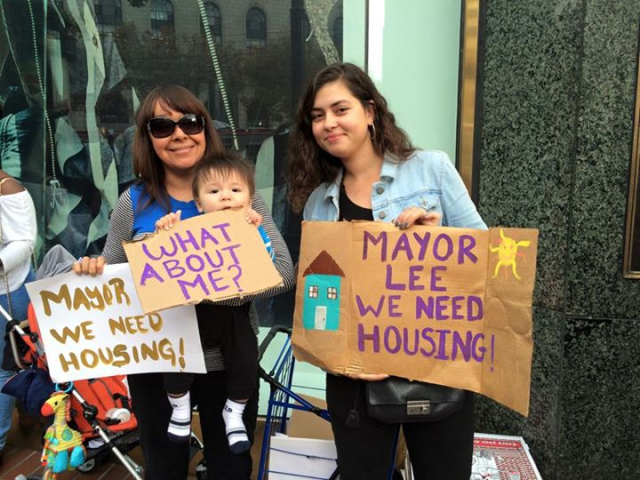Let’s make a plan to put 6,000 homeless people into housing. It’s something the city can do
By Jennifer Friedenbach
In my 20 years of working on homeless issues in San Francisco, I have seen my share of city homeless czars come and go under various mayors. Some have been experienced with the issue, while others were given the job due to political favors. I have even seen the position eliminated to fund a homeless family drop-in center, and then later saw it re-instated.
The position, generally speaking, has been a shill for whatever mayor happens to be in charge. The homeless coordinators go out to speak at police meetings, where citizens make awful and sometimes helpful comments about our poorest residents; they promise to call in the police or outreach workers, they do public relations, and appease the citizenry by having someone important show up and listen. They have often played into the very myths that let our policy makers off the hook, by talking about how wonderful city services are, how homeless people are just refusing them, how the more they do, the more homeless people flock to the city. All of this is done in the name of protecting that particular mayor’s good name.
Homelessness is probably the most politically charged issue in San Francisco. It’s used as a wedge issue to get elected, the population shamelessly scapegoated for political gain. Often solutions presented are political in nature – they sound great but really there is no substance behind them.
A classic example is the aggressive panhandling measure put on the ballot by then mayoral hopeful Gavin Newsom. The measure went to voters with messaging that demonized homeless people, but at the same time offered a feel-good effect. The measure did call for jail time for aggressive panhandling, but also offered treatment as a solution.
Of course, it assumed all panhandlers were addicts, but did not offer any funding for treatment, and there were long lines for treatment already. It was a silly measure. Barely any tickets have been given out and no one has gotten treatment out of it, either. But it did succeed in positioning Newsom just so, motivated conservative voters to come out to vote, and it passed, giving Newsom a feather in his cap for “getting things done!”
There are dozens of examples of just that.
When Mayor Lee was elected, he kept pretty much the entire Brown/Newsom administration intact, the leadership of whom favor a divisive approach to politics, and yet he called for a new consensus based approach. He changed up the MTA head, moving former DPW head Ed Reiskin over. Everything else stayed pretty much the same.
The one difference is he appointed former supervisor and Lee Mayoral opponent Bevan Dufty to the head of the homeless office. Dufty asked for staffing, renamed the office “HOPE” and quickly got to work.
The interesting thing about Dufty is that he treated the job very differently from all his predecessors. He saw homeless people and homeless service providers as his constituents. He reached out to them, found out what was working for them and what needed to change. This demonstrated a true desire to find real solutions to the issue of homelessness. Not just solutions that made great sound bites, but sustained solutions that truly made a difference.
One example: He heard from homeless people, advocates, and service providers that the shelter access system was highly problematic. Homeless people were spending upwards of 13 hours trying to get a shelter bed – it was a line-based system. His very competent staff person, Amanda Fried, held a community process to re-design the system. They worked with us at the Coalition on Homelessness to get deep input from homeless people in shelter and on what a new model could look like. Fried held an open, consensus-based process to come up with the new system including homeless people, homeless providers and other community members.
It worked. The new system was far better than anything that bureaucrats three degrees disconnected from homeless people could have designed. Away went the lines, and an easy call in system was created through 311.
The result was that homeless people could spend more time finding work and housing, and taking care of their medical needs. Folks who never were able to access shelter before, such as elderly people, are now able to access shelter.
Dufty respected community. He didn’t see a problem working with the people who are responsible for implementing solutions, or who know the system best because they are living it. He was even able to garner support from community members on mayoral initiatives. Even as he remained loyal to the mayor, he was able to navigate overwhelming community need and pressure. As a result, we made headway on homeless systems that had been juggernauted for years because of politics and ego.
Dufty is now soon retired from that job, and Sam Dodge from his office will be replacing him in the interim. It is a great time to pause and think of what we need from a new Director of HOPE.
We need someone who is connected to homeless people themselves. This has been a great learning tool for Dufty, who discovered system flaws helping homeless people. It doesn’t need to take up all the new person’s time, but it is critical to stay connected to what is really going on. Just think how much better our city would run if all our top dogs were drinking from the same river as the rest of the pueblo.
So often, our policies are made around homelessness without any input from homeless people. They are politically driven, and sometimes clever from that perspective, but rarely hit the “true solution” mark if homeless people were not involved in the development of said initiatives.
The position is a challenging one – it is a policy head of an extremely politicized issue, and the person must respond to grumpy neighbors, pissed off homeless people, excitable community activists, and balance the political goals of the mayoral administration. In other words, the homeless director gets it from all sides. The only way to succeed is to be transparent, honest, and have a great deal of integrity.
The director should also have a vision that translates into motivation. Sitting back and going with the status quo – such as continuing our primary response to homelessness via a squad car that moves the homeless person half a block down the street – just is not going to get us anywhere on this issue.
We need to be open to creativity, to thinking big and really solving this issue. The current system is stymied by a culture that believes that homeless people are choosing a life of misery on the streets, and that the city’s responsibility is to make it as uncomfortable as possible for them so that they simply disappear. This clearly isn’t working. People have nowhere to go.
In fact the overwhelming majority of homeless people become homeless as San Franciscans, and here is the true surprise; being homeless is not fun. You lose 20 years off your life, and get treated horribly by people you don’t know. The practice of making things uncomfortable for homeless people has instead perpetuated poverty by creating real barriers to exiting homelessness.
The new czar needs to be able to rise above the politics, and not respond to news cycles and the whims of politicians. Politics are why our city homeless policies are so bizarre– our system is complaint driven instead of need driven and we prioritize income source over equity in terms of deciding who gets housing.
The big homeless issues the new homeless czar needs to tackle:
Family homelessness
Our numbers of homeless children have doubled in the past five years, time to end family homelessness. We know how, and we can do it!
Housing
Let’s make a plan to house another 6,000 currently homeless households. Figure out how much it would cost. Find an income source if needed, a progressive tax targeting speculators or another idea. Double the number of homeless units in the affordable housing pipeline, and then speed up construction on the ones farther down the pipeline, prioritize turnover units to homeless people. Some of that housing needs to be supportive housing to address special needs, but for many folks, they just need the lower rents. Get creative.
Criminalization
The tide is turning on this issue – we don’t need to call police in to address homelessness. Let’s change the protocol, send an outreach worker, and put them in the 6,000 units of new housing! We want to see a difference on our streets? Moving people around is a waste of resources. Moving them into housing is a solution and yes, we can do this if we choose to as a city.
Prevention
Evictions are the driving force of homelessness. The new Director should make it a priority to keep people housed. Ensure a responsive and comprehensive system that includes public and private housing. If an eviction can be prevented it should be prevented, whether that takes legal intervention, or bridge rent.
Mental Health and Substance Abuse
While housing is a key component to getting healthy, we still have a long ways to go to ensure folks have treatment on demand. We have made some gains around community crisis care, and will be expanding badly needed medical detox, but we still have a ways to go in ensuring we have comprehensive community based care. These are health issues, and should be thought of the same way. We don’t deny treatment for diabetics, so why shouldn’t we have the health care capacity to treat all those who need it for behavioral health issues.
Employment
Probably the weakest element of our poverty abatement system is training and jobs. We have some great programs through the state cash assistance programs and our supportive housing programs, but as a city we invest very little in this area for homeless people. We need to assess what is working and do more to close the economic chasm in SF.
Addressing Street Based Issues
While folks are forced to remain on the streets, we need to make sure they have access to restrooms and showers and street based health care. Ensure there are safe sharps containers to deposit dirty needles. Pass out garbage bags and brooms so folks can help keep their spaces clean. Make sure there are safe places to park for folks in vehicles. Until folks have access to housing, conducting sweeps needs to stop. It is inhumane.
Navigation Center
This is a temporary shelter set up in mobile units in unused city land. This has been successful because there are real resources such as housing and public benefits attached to this center and not a lot of red tape to get in. The same level of resources needs to be applied to our entire emergency homeless system.
This is a tall order, but with a homeless policy director deliberately working diligently side by side with the community, it can be achieved. The new director should be someone who isn’t afraid to work with community members, and the administration should welcome that instead of viewing it as consorting with the enemy. If we are to solve this issue, we need to work together, and that means respecting the real life experiences of homeless people and front line service providers. They are doing this every day, and know what works and what doesn’t. That doesn’t take away from a victory for the mayor. This isn’t a tennis match – there are no two sides, just one side working towards solving homelessness. Real solutions are real wins for the mayor’s legacy.





